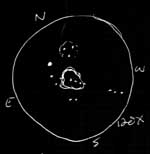
Observation Notes:
Through the 25 mm eyepiece, this globular cluster was dim and small, but still remarkably grainy. It was also elongated. In the 10 mm eyepiece a number of stars showed at the edges and a few across the face. The shape was irregular, and seemed to make a soft arrowhead pointing WSW. An asterism of 4 stars across the surface points WSW too and leads to another line of 3 stars outside, pointing in the same direction. Not sure, but it looks like there is a detached clump of stars to the north with 3 brighter stars involved.
Factoids:
There has been a lot of confusion as to whether M71 should be considered a loose globular, or a dense open cluster. Not just because it is pretty loose for a globular, but also because it has a high metal content (only M69 has more), and it is fairly small at 27 light years across. Currently, it is considered to be a globular. It is 13,000 light years away, and is approaching at roughly 23 km/sec. M71 was first seen by De Chéseaux in 1746, and then catalogued by Charles Messier in 1780, and then first resolved into stars by William Herschel in 1783.
| Subject | M71/NGC 6838 |
| Classification | Globular Cluster |
| Position | Sagitta [RA: 19:53.8 / Dec: +18:47]* |
| Size* | 7.2′ |
| Brightness* | 8.2 |
| Date/Time | 10/4/04 – 9:30 PM |
| Observing Loc. | Flagstaff, AZ – Home |
| Instrument | Orion SVP 6LT Reflector (150 mm dia./1200 mm F/L) |
| Eyepieces/Mag. | 25 mm (48X); 10 mm (120X) |
| Seeing | 4/10 |
| Transparency | Mag 5 |
* Based on published data.